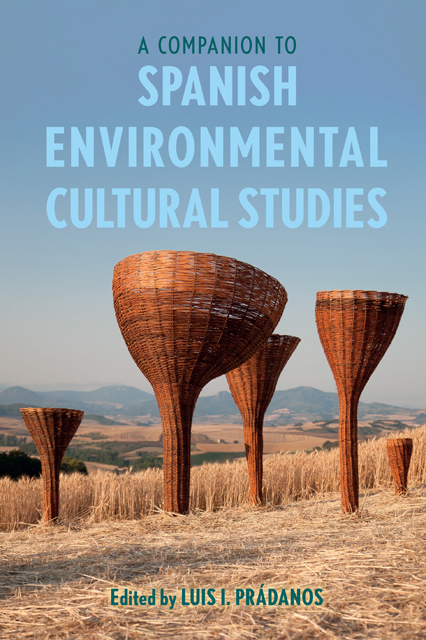Book contents
- Frontmatter
- Contents
- List of Illustrations
- List of Contributors
- Note on the Translations
- Acknowledgements
- Introduction: Spanish Environmental Cultural Studies
- Part I Environmental Cultural History and Political Ecology
- Part II Water and Power
- Part III Ecologies of Memory and Extractivism
- Part IV Animal Studies and Multispecies Ethnographies
- Part V Food Studies and Exploitative Ecologies
- Part VI Ecofeminism
- Part VII (Neo)Colonial and Racialized Ecologies
- Part VIII Tourism and the Environmental Imagination
- Part IX Eco-Mediation and Representation
- Part X Trash and Discard Studies
- Bibliography
- Index
21 - Spanish Film and the Environment
Published online by Cambridge University Press: 08 June 2023
- Frontmatter
- Contents
- List of Illustrations
- List of Contributors
- Note on the Translations
- Acknowledgements
- Introduction: Spanish Environmental Cultural Studies
- Part I Environmental Cultural History and Political Ecology
- Part II Water and Power
- Part III Ecologies of Memory and Extractivism
- Part IV Animal Studies and Multispecies Ethnographies
- Part V Food Studies and Exploitative Ecologies
- Part VI Ecofeminism
- Part VII (Neo)Colonial and Racialized Ecologies
- Part VIII Tourism and the Environmental Imagination
- Part IX Eco-Mediation and Representation
- Part X Trash and Discard Studies
- Bibliography
- Index
Summary
Film and the Environment: A Tense Relationship
The relationship between film and the environment is tense and contradictory. On the one hand, film is a highly globalized industry that relies on costly technology; uses enormous amounts of energy; emits vast quantities of waste, pollution and greenhouse gases; and has been, throughout its history, a major promoter of consumerism and an agent of global capitalism’s obsession with growth and profits at any cost. On the other hand, film may be a powerful vehicle of environmental awareness, a promoter of intercultural dialogues, a tool for activism, and generally a force for social and environmental transformation. For the same reasons, film may be a useful educational resource and an effective instrument of eco-pedagogy.
Historically, the environmental destruction carried out by the film and audiovisual media industry has outweighed its benefits as a vehicle for environmental education and activism. All the phases of film production, distribution, and consumption have a heavy environmental impact: in the shooting phase, large amounts of electricity are required for the lighting, cameras, and other equipment; tons of materials and resources are used for the building of the stage sets; vast quantities of fuel are burnt for transportation, catering, and water supply; film productions take a severe toll on the locations where the films are shot, with hundreds of people and vehicles disturbing and eroding the landscapes for weeks at a time. Productions are eminently wasteful, with an average of 95 percent of the materials not being reused or recycled. Likewise, film distribution and consumption use an inordinate amount of energy and produce enormous quantities of greenhouse gases, pollution, and waste. Digital film and video have a particularly deep environmental impact, as viewing films online is much more damaging than watching them in movie theaters. By 2025, digital technologies will be responsible for 8 percent of the world’s greenhouse gas emissions, with 80 percent of data traffic corresponding to digital video. To put that into perspective, the CO2 emissions of streaming video worldwide reached 300 million tons in 2018, roughly equal to the total national output of Spain.
“Green” Initiatives in the Spanish Film Industry
Only in recent years have the film and video industries started to acknowledge their responsibility and to propose measures to limit their environmental impact.
- Type
- Chapter
- Information
- A Companion to Spanish Environmental Cultural Studies , pp. 223 - 230Publisher: Boydell & BrewerPrint publication year: 2023



